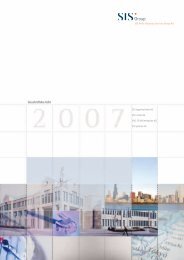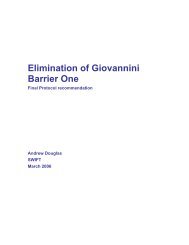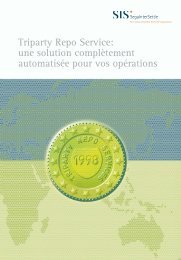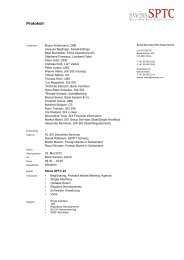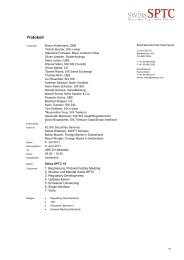Market Standards for Corporate Actions Processing - SIX Securities ...
Market Standards for Corporate Actions Processing - SIX Securities ...
Market Standards for Corporate Actions Processing - SIX Securities ...
Create successful ePaper yourself
Turn your PDF publications into a flip-book with our unique Google optimized e-Paper software.
Final and endorsed version 2009<br />
<strong>Market</strong> <strong>Standards</strong> <strong>for</strong> <strong>Corporate</strong> <strong>Actions</strong> <strong>Processing</strong><br />
1
Table of contents<br />
Introduction 3<br />
Glossary 6<br />
Sequence of dates graphs 10<br />
Distributions<br />
Cash Distributions 11<br />
<strong>Securities</strong> Distributions 16<br />
Distributions with Options 21<br />
Reorganisations<br />
Mandatory Reorganisations with Options 24<br />
Mandatory Reorganisations 29<br />
Voluntary Reorganisations 34<br />
Transaction Management 39<br />
<strong>Market</strong> Claims 41<br />
Trans<strong>for</strong>mations 43<br />
Buyer Protection 45<br />
Annex 1: Members of the <strong>Corporate</strong> <strong>Actions</strong> Joint Working Group 47<br />
2
Introduction<br />
In the Giovannini Reports corporate actions processing is dealt with as Barrier 3, where, referring to the existing national differences,<br />
the operational problems are characterised by “the variety of rules, in<strong>for</strong>mation requirements and deadlines <strong>for</strong> corporate actions.<br />
These differences may require specialised local knowledge or the lodgement of physical documents locally, and so inhibit the<br />
centralisation of securities settlement.”<br />
<strong>Corporate</strong> actions processing is deemed one of the most complex areas of post trading. Standardising these processes across all<br />
European markets, and possibly beyond, aims at achieving a significant reduction of respective costs and operational risks. To<br />
dismantle Giovannini Barrier 3, investments may be required in order to become compliant with the standards on corporate actions<br />
processing. However, upon implementation of the standards, the European securities market and its users will benefit from cost<br />
savings resulting from harmonising the processes cross border.<br />
Individual work of associations contributing to the dismantling of Giovannini Barrier 3 was replaced in summer 2007 by the set up of<br />
the <strong>Corporate</strong> <strong>Actions</strong> Joint Working Group (CAJWG) 1 that encompasses the main relevant constituencies, i.e. Issuers, market<br />
infrastructures and intermediaries. The CAJWG’s objective has been to develop a comprehensive set of market standards <strong>for</strong><br />
the operational processing of all categories of corporate actions 2 including transaction management.<br />
This document contains the standards proposed by the CAJWG, reviewed in the 1 st quarter 2009 in consideration of the responses to<br />
the market consultation of the 4 th quarter 2008 and endorsed by the involved associations: EuropeanIssuers, European Central<br />
<strong>Securities</strong> Depositories Association (ECSDA), European Association of Clearing Houses (EACH), Federation of European <strong>Securities</strong><br />
Exchanges (FESE), European Banking Federation (EBF), European Association of Cooperative Banks (EACB), European Savings<br />
Banks Group (ESBG), European <strong>Securities</strong> Services Forum (ESSF/SIFMA).<br />
1 See Annex 1<br />
2 Except <strong>for</strong> general meetings that is the subject of the Joint Working Group on General Meetings<br />
3
The CAJWG has agreed on basic principles whereby the standards should be based on work already per<strong>for</strong>med and should reflect<br />
future best market practices (rather than solutions currently applied in most markets) that, once implemented, should dismantle the<br />
operational part of Barrier 3 as concerns the categories of <strong>Corporate</strong> <strong>Actions</strong> addressed.<br />
The proposed market standards cover the following categories of <strong>Corporate</strong> <strong>Actions</strong> (rather than individual event types) as well as<br />
transaction management:<br />
• Distributions<br />
o Distributions:<br />
Cash Distributions (e.g. cash dividend, interest payment)<br />
<strong>Securities</strong> Distributions (e.g. stock dividend, bonus issue)<br />
o Distributions with Options (e.g. optional dividend)<br />
• Reorganisations<br />
o Mandatory Reorganisations with Options (e.g. conversion)<br />
o Mandatory Reorganisations (e.g. stock split, redemption)<br />
o Voluntary Reorganisations (e.g. tender offer)<br />
• Transaction Management<br />
o <strong>Market</strong> Claims (Distributions)<br />
o Trans<strong>for</strong>mations (Reorganisations)<br />
o Buyer Protection (Elective <strong>Corporate</strong> <strong>Actions</strong>)<br />
The scope of application of the proposed market standards includes<br />
• all types of the above categories of <strong>Corporate</strong> <strong>Actions</strong> (Distributions and Reorganisations)<br />
• all securities deposited and settled in Book Entry <strong>for</strong>m with an (I)CSD in Europe<br />
• all parties involved, i.e. Issuers, market infrastructures (trading, clearing and settlement), Intermediaries and End Investors,<br />
except <strong>for</strong> standards <strong>for</strong> transaction management which are directed at market infrastructures and Intermediaries only.<br />
4
The subject matter of the standards concerns<br />
• the in<strong>for</strong>mation flow throughout the chain of relevant parties<br />
• key dates and their sequence<br />
• the operational processing of <strong>Corporate</strong> <strong>Actions</strong>.<br />
It is important to note that, within the standards, entitlements are determined from the actual settled positions in the Issuer (I)CSD’s<br />
books on Record Date, whereas Intermediaries may calculate on a contractual settlement basis on Ex Date.<br />
The CAJWG takes the view that in order to reap the full benefits of the proposed standards the harmonisation of<br />
Settlement Cycles in Europe is required. However, the implementation of the proposed standards should not be delayed in the<br />
absence thereof.<br />
5
Glossary<br />
Note: Definitions given in this glossary are <strong>for</strong> the purpose of the standards on <strong>Corporate</strong> <strong>Actions</strong> only and are not intended to have<br />
any legal connotations or to reflect current market practices.<br />
Actual Settlement Date Date on which the settlement effectively takes place.<br />
Bilateral Input Instructions submitted by both parties to settlement as opposed to direct input, which is<br />
submitted by third parties.<br />
Book Entry Accounting of securities and other financial assets in dematerialised or immobilised <strong>for</strong>m.<br />
Business Day Business day at the Issuer (I)CSD.<br />
Buyer Protection Process whereby a buyer who has yet to receive the Underlying <strong>Securities</strong> of an Elective<br />
<strong>Corporate</strong> Action, instructs the seller in order to receive the outturn of his choice.<br />
Buyer Protection Deadline Last day and time by which a Buyer Protection instruction can be given.<br />
CCP Central counterparty, i.e. an entity that interposes itself between the two parties to a trade,<br />
becoming the buyer to every seller and the seller to every buyer.<br />
Cash Distribution A Distribution where the proceeds consist of cash only.<br />
Chain of Intermediaries Sequence of Intermediaries connecting the Issuer / Issuer CSD with the End Investor and vice<br />
versa in respect of securities held by Book Entry in a securities account.<br />
<strong>Corporate</strong> Action Action initiated upon a security by the Issuer or an Offeror.<br />
Distribution <strong>Corporate</strong> Action whereby the Issuer of a security delivers particular proceeds to the holder of<br />
the Underlying Security without affecting the Underlying Security.<br />
6
Distribution with Options A Distribution with a choice of proceeds.<br />
Election Period Period during which elections can be made.<br />
Elective <strong>Corporate</strong> Action Distribution with Options, Mandatory Reorganisation with Options or Voluntary Reorganisation.<br />
End Investor Physical or legal person who holds the security <strong>for</strong> his own account, not including the holder of<br />
a unit of a UCIT (undertaking <strong>for</strong> collective investments in transferable securities).<br />
Ex Date Date from which the Underlying Security is traded without the benefit / right attached to it.<br />
Fractions The number of Underlying <strong>Securities</strong> remaining after the calculation of the entitlement to the<br />
proceeds of a <strong>Corporate</strong> Action.<br />
or<br />
The decimal part of the balance of outturn securities resulting from the calculation of the<br />
proceeds of a <strong>Corporate</strong> Action.<br />
Guaranteed Participation Date Last date to buy the Underlying Security with the right attached to participate in an Elective<br />
<strong>Corporate</strong> Action.<br />
(I)CSD (International) Central <strong>Securities</strong> Depository<br />
Intended Settlement Date Date on which a Transaction is due to settle.<br />
Interim Security Short term transferable operational instrument, issued <strong>for</strong> processing purposes only, which is<br />
not representative of the Issuer’s capital.<br />
Intermediaries Financial institutions that provide and maintain securities accounts.<br />
Investor (I)CSD (I)CSD that holds securities with another (I)CSD or with an Intermediary.<br />
ISIN International <strong>Securities</strong> Identification Number<br />
7
ISO International Organization <strong>for</strong> Standardisation<br />
Issuer The issuer of an Underlying Security including the agent mandated by the Issuer <strong>for</strong> <strong>Corporate</strong><br />
<strong>Actions</strong> purposes.<br />
Issuer (I)CSD (I)CSD with whom the Issuer has deposited and maintains its primary securities issuance by<br />
Book Entry.<br />
Mandatory Reorganisation A Reorganisation that mandatorily affects the Underlying Security.<br />
Mandatory Reorganisation A Mandatory Reorganisation with a choice of proceeds.<br />
with Options<br />
<strong>Market</strong> Claim Process to reallocate the proceeds of a Distribution to the contractually entitled party.<br />
<strong>Market</strong> Deadline Last date and time, preferably end of day, to send election instructions to the Issuer (I)CSD.<br />
Matching Process of comparing the two relevant settlement instructions as provided by the two<br />
counterparties to ensure that they match.<br />
Offeror Party (other than the Issuer) including its agent, offering a Voluntary Reorganisation.<br />
Payment Delivery of the proceeds of a <strong>Corporate</strong> Action.<br />
Payment Date Date on which the Payment is due.<br />
Pending Transaction Unsettled Transaction.<br />
Record Date Date on which settled positions are struck in the books of the Issuer (I)CSD at close of<br />
business to determine the entitlement to the proceeds of a <strong>Corporate</strong> Action.<br />
Reorganisation A <strong>Corporate</strong> Action whereby the Underlying Security is replaced with proceeds.<br />
8
<strong>Securities</strong> Distribution A Distribution where the proceeds consist of securities.<br />
Settlement Cycle Number of Business Days from the trade date to the Intended Settlement Date.<br />
Transaction The result of Matching.<br />
Trans<strong>for</strong>mation Process by which Pending Transactions, on or after Record Date / <strong>Market</strong> Deadline, are<br />
cancelled and replaced by new Transactions in accordance with the terms of the<br />
Reorganisation.<br />
Underlying Security Security that is the subject of a <strong>Corporate</strong> Action.<br />
Underlying Transaction Transaction upon which a <strong>Market</strong> Claim, Trans<strong>for</strong>mation or Buyer Protection is applied.<br />
Voluntary Reorganisation A Reorganisation in which participation is optional <strong>for</strong> the holder of the Underlying Security.<br />
9
Sequence of dates graphs<br />
Graphs in this document are <strong>for</strong> illustrative purposes only; please refer to the standards <strong>for</strong> a detailed description of the timelines.<br />
In the absence of harmonised Settlement Cycles, the graphs in this document do not use a day-by-day timeline. They show the<br />
sequence of key dates as well as the length of intervals between key dates including the relevant daytime of these dates.<br />
10
Cash Distributions<br />
11
Cash Distributions<br />
Sequence of dates<br />
minimum two Business Days<br />
Note that the Ex Date is not applicable to securities in nominal, e.g. bonds<br />
Settlement Cycle minus one Business Day<br />
12<br />
preferably one Business Day
<strong>Market</strong> <strong>Standards</strong> <strong>for</strong> Cash Distributions<br />
In<strong>for</strong>mation from Issuer to Issuer (I)CSD<br />
1. The Issuer should in<strong>for</strong>m its Issuer (I)CSD of the details of a Cash Distribution, including the key dates, as soon as the Issuer<br />
has publicly announced the <strong>Corporate</strong> Action according to applicable law. It should also in<strong>for</strong>m the Issuer (I)CSD of any change<br />
or confirmation of the <strong>Corporate</strong> Action.<br />
2. For floating rate instruments, the Payment Date confirmation and the announcement of the next applicable rate with reference<br />
to the applicable period <strong>for</strong> that new rate should be made in two separate announcements and not combined in the same.<br />
3. The in<strong>for</strong>mation should be communicated in <strong>for</strong>matted electronic <strong>for</strong>m using standards defined and used by the securities<br />
industry, such as the ISO standards, irrespective of the communication channel used.<br />
4. For narrative text in the in<strong>for</strong>mation, Issuers with an international shareholder base should use at least a language customary in<br />
the sphere of international finance, currently English.<br />
In<strong>for</strong>mation from Issuer (I)CSD to its participants<br />
5. The Issuer (I)CSD should communicate the in<strong>for</strong>mation, and any subsequent in<strong>for</strong>mation, without undue delay of receipt from<br />
the Issuer, to all its participants 1 who, at the time of the announcement, have a direct holding or Pending Transaction in the<br />
Underlying Security with the Issuer (I)CSD.<br />
6. The Issuer (I)CSD should also in<strong>for</strong>m, without undue delay, any participant who obtains a holding or is subject to a new<br />
Transaction on the Underlying Security after the announcement until the Record Date.<br />
7. The in<strong>for</strong>mation should be communicated in <strong>for</strong>matted electronic <strong>for</strong>m using standards defined and used by the securities<br />
industry, such as the ISO standards, irrespective of the communication channel used.<br />
8. If a Payment needs to be reversed, an announcement, including the reason <strong>for</strong> such reversal, should be made by the Issuer<br />
(I)CSD to all affected parties prior to processing the reversal.<br />
1 Including Investor (I)CSDs<br />
13
In<strong>for</strong>mation flow from (I)CSD participants to End Investors<br />
9. (I)CSD participants, their clients and the onward Chain of Intermediaries, each at its respective level towards its own clients,<br />
should comply with standards 5 and 6 above until the in<strong>for</strong>mation reaches the End Investor. For End Investors, in<strong>for</strong>mation by<br />
means of account statement is deemed sufficient unless provided otherwise in their service level agreement.<br />
10. The in<strong>for</strong>mation should be communicated to Intermediaries in <strong>for</strong>matted electronic <strong>for</strong>m using standards defined and used by<br />
the securities industry, such as the ISO standards, irrespective of the communication channel used.<br />
11. The in<strong>for</strong>mation should be communicated to non-Intermediaries, including End Investors, in a clear and comprehensible way.<br />
12. Key dates are:<br />
Key dates<br />
a) <strong>for</strong> Distributions relating to securities in nominal (e.g. bonds): Record Date and Payment Date.<br />
b) <strong>for</strong> Distributions relating to securities in units (e.g. shares): Ex Date, Record Date and Payment Date.<br />
13. The public announcement by the Issuer under standard 1 above should be made at least two Business Days be<strong>for</strong>e the Ex<br />
Date.<br />
14. For floating rate instruments, the payable rate should be confirmed as soon as possible but no later than three Business Days<br />
be<strong>for</strong>e the Payment Date.<br />
15. The Ex Date should precede the Record Date by one Settlement Cycle minus one Business Day.<br />
16. The Payment Date should be as close as possible to the Record Date, preferably the next Business Day.<br />
14
<strong>Processing</strong><br />
17. Payments should be by Book Entry.<br />
18. Interest Payments should be processed separately from redemptions even if their Payment Dates coincide.<br />
19. All Cash Distributions and related <strong>Market</strong> Claims should be paid in cash and not coupons.<br />
20. For Payments, the following should apply:<br />
a) From Issuers to (I)CSD participants, Payments should be made through the Issuer (I)CSD, using the same Payment<br />
mechanism as <strong>for</strong> other cash transactions through the Issuer (I)CSD.<br />
b) Payments by Issuers and Issuer (I)CSDs should be in the original currency as per the announcement under standard 1<br />
above.<br />
c) The Issuer should make Payments as early as possible after opening of the Payment system and no later than 12:00 noon<br />
Issuer (I)CSD local time.<br />
d) No blocking of holdings <strong>for</strong> the purpose of Cash Distributions.<br />
e) If a correction of the Payment is necessary, it should take the <strong>for</strong>m of a complete reversal of the Payment followed by a new<br />
correct Payment.<br />
15
<strong>Securities</strong> Distributions<br />
16
<strong>Securities</strong> Distributions<br />
Sequence of dates<br />
minimum two Business Days<br />
Settlement Cycle minus one Business Day<br />
17<br />
One Business Day
<strong>Market</strong> <strong>Standards</strong> <strong>for</strong> <strong>Securities</strong> Distributions<br />
In<strong>for</strong>mation from Issuer to Issuer (I)CSD<br />
1. The Issuer should in<strong>for</strong>m its Issuer (I)CSD of the details of a <strong>Securities</strong> Distribution, including the key dates and the ISIN of the<br />
outturn security, as soon as the Issuer has publicly announced the <strong>Corporate</strong> Action according to applicable law. It should also<br />
in<strong>for</strong>m the Issuer (I)CSD of any change or confirmation of the <strong>Corporate</strong> Action and, if applicable, of the reference price <strong>for</strong><br />
compensation of Fractions by the Issuer.<br />
2. The in<strong>for</strong>mation should be communicated in <strong>for</strong>matted electronic <strong>for</strong>m using standards defined and used by the securities<br />
industry, such as the ISO standards, irrespective of the communication channel used.<br />
3. For narrative text in the in<strong>for</strong>mation, Issuers with an international shareholder base should use at least a language customary in<br />
the sphere of international finance, currently English.<br />
In<strong>for</strong>mation from Issuer (I)CSD to its participants<br />
4. The Issuer (I)CSD should communicate the in<strong>for</strong>mation, and any subsequent in<strong>for</strong>mation, without undue delay of receipt from<br />
the Issuer, to all its participants 1 who, at the time of the announcement, have a direct holding or Pending Transaction in the<br />
Underlying Security with the Issuer (I)CSD.<br />
5. The Issuer (I)CSD should also in<strong>for</strong>m, without undue delay, any participant who obtains a holding or is subject to a new<br />
Transaction on the Underlying Security after the announcement until the Record Date.<br />
6. The in<strong>for</strong>mation should be communicated in <strong>for</strong>matted electronic <strong>for</strong>m using standards defined and used by the securities<br />
industry, such as the ISO standards, irrespective of the communication channel used.<br />
7. If a Payment needs to be reversed, an announcement, including the reason <strong>for</strong> such reversal, should be made by the Issuer<br />
(I)CSD to all affected parties prior to processing the reversal.<br />
1 Including Investor (I)CSDs<br />
18
In<strong>for</strong>mation flow from (I)CSD participants to End Investors<br />
8. (I)CSD participants, their clients and the onward Chain of Intermediaries, each at its respective level towards its own clients,<br />
should comply with standards 4 and 5 above until the in<strong>for</strong>mation reaches the End Investor. For End Investors, in<strong>for</strong>mation by<br />
means of account statement is deemed sufficient unless provided otherwise in their service level agreement.<br />
9. The in<strong>for</strong>mation should be communicated to Intermediaries in <strong>for</strong>matted electronic <strong>for</strong>m using standards defined and used by<br />
the securities industry, such as the ISO standards, irrespective of the communication channel used.<br />
10. The in<strong>for</strong>mation should be communicated to non-Intermediaries, including End Investors, in a clear and comprehensible way.<br />
Key dates<br />
11. Key dates are Ex Date, Record Date and Payment Date.<br />
12. The public announcement by the Issuer under standard 1 above should be made at least two Business Days be<strong>for</strong>e the Ex<br />
Date.<br />
13. The Ex Date should precede the Record Date by one Settlement Cycle minus one Business Day.<br />
14. The Payment Date should be the next Business Day after Record Date.<br />
<strong>Processing</strong><br />
15. Payments should be by Book Entry.<br />
16. For Payments in securities, the following should apply:<br />
a) The Issuer should make Payments through the (I)CSD as early as possible and no later than the opening of the settlement<br />
system <strong>for</strong> settlement on the relevant Payment Date.<br />
b) The Payments should be processed by rounding down to the nearest whole number (top-down method).<br />
c) When Fractions occur and the Issuer compensates them in cash at the level of the Issuer (I)CSD, the Issuer (I)CSD<br />
participants and all the Intermediaries down the chain should on their turn, each at its respective level, also compensate any<br />
Fractions in cash.<br />
19
17. For Payments of Fractions in cash, where applicable, the following should apply:<br />
a) From Issuers to (I)CSD participants, Payments should be made through the Issuer (I)CSD, using the same Payment<br />
mechanism as <strong>for</strong> other cash transactions through the Issuer (I)CSD.<br />
b) Payments by Issuers and Issuer (I)CSDs should be in the original currency as per the announcement under standard 1<br />
above.<br />
c) The Issuer should make Payments as early as possible after opening of the Payment system and no later than 12:00 noon<br />
Issuer (I)CSD local time.<br />
d) If a correction of the Payment is necessary, it should take the <strong>for</strong>m of a complete reversal of the Payment followed by a new<br />
correct Payment.<br />
20
Distributions with Options<br />
21
Distributions with Options<br />
Overall sequence of dates<br />
minimum two Business Days<br />
Distribution<br />
Settlement Cycle minus one Business Day<br />
One Business Day<br />
minimum fifteen Business Days<br />
Mandatory Reorganisation with Options<br />
Minimum ten Business Days<br />
Settlement Cycle plus two hours<br />
22<br />
minimum one Business Day<br />
preferably one Business Day
<strong>Market</strong> <strong>Standards</strong> <strong>for</strong> Distributions with Options<br />
1. Distributions with Options should be represented by an Interim Security with an official ISIN.<br />
2. The issuance of the Interim Security and the options attached to it should be operationally treated as two separate <strong>Corporate</strong><br />
<strong>Actions</strong>, the first being a Distribution, the second a Mandatory Reorganisation with Options (or a Voluntary Reorganisation).<br />
They should be communicated to the Issuer (I)CSD at the same time and the second <strong>Corporate</strong> Action type should be indicated<br />
in the in<strong>for</strong>mation of the first <strong>Corporate</strong> Action.<br />
3. The standards <strong>for</strong> <strong>Securities</strong> Distributions should apply to the first <strong>Corporate</strong> Action, i.e. the Distribution.<br />
4. The standards <strong>for</strong> Mandatory Reorganisations with Options (or Voluntary Reorganisations) should apply to the second<br />
<strong>Corporate</strong> Action, i.e. the Mandatory Reorganisation with Options (or the Voluntary Reorganisation).<br />
5. The Election Period determined by the Issuer should not start be<strong>for</strong>e the Payment Date of the Interim Security.<br />
6. The Intended Settlement Date of any Transaction in the Interim Security should not be prior to the Payment Date of the Interim<br />
Security.<br />
23
Mandatory Reorganisations with Options<br />
24
Mandatory Reorganisations with Options<br />
Sequence of dates<br />
minimum two Business Days<br />
minimum ten Business Days<br />
Settlement Cycle plus two hours<br />
25<br />
minimum one Business Day<br />
preferably one Business Day
<strong>Market</strong> <strong>Standards</strong> <strong>for</strong> Mandatory Reorganisations with Options<br />
In<strong>for</strong>mation from Issuer to Issuer (I)CSD<br />
1. The Issuer should in<strong>for</strong>m its Issuer (I)CSD of the details of a Mandatory Reorganisation with Options, including the key dates<br />
and the Issuer default option, as soon as the Issuer has publicly announced the <strong>Corporate</strong> Action according to applicable law. It<br />
should in<strong>for</strong>m the Issuer (I)CSD also in case of a change or confirmation of the <strong>Corporate</strong> Action and, if applicable, of the<br />
reference price <strong>for</strong> compensation of Fractions by the Issuer.<br />
2. The in<strong>for</strong>mation should be communicated in <strong>for</strong>matted electronic <strong>for</strong>m using standards defined and used by the securities<br />
industry, such as the ISO standards, irrespective of the communication channel used.<br />
3. For narrative text in the in<strong>for</strong>mation, Issuers with an international shareholder base should use at least a language customary in<br />
the sphere of international finance, currently English.<br />
In<strong>for</strong>mation from Issuer (I)CSD to its participants<br />
4. The Issuer (I)CSD should communicate the in<strong>for</strong>mation, and any subsequent in<strong>for</strong>mation, without undue delay of receipt from<br />
the Issuer, to all its participants 1 who, at the time of the announcement, have a direct holding or Pending Transaction in the<br />
Underlying Security with the Issuer (I)CSD.<br />
5. The Issuer (I)CSD should also in<strong>for</strong>m, without undue delay, any participant who obtains a holding or is subject to a new<br />
Transaction on the Underlying Security after the announcement until the <strong>Market</strong> Deadline.<br />
6. The in<strong>for</strong>mation should be communicated in <strong>for</strong>matted electronic <strong>for</strong>m using standards defined and used by the securities<br />
industry, such as the ISO standards, irrespective of the communication channel used.<br />
7. If a Payment needs to be reversed, an announcement, including the reason <strong>for</strong> such reversal, should be made by the Issuer<br />
(I)CSD to all affected parties prior to processing the reversal.<br />
1 Including Investor (I)CSDs<br />
26
In<strong>for</strong>mation flow from (I)CSD participants to End Investors<br />
8. (I)CSD participants, their clients and the onward Chain of Intermediaries, each at its respective level towards its own clients,<br />
should comply with standards 4 and 5 above until the in<strong>for</strong>mation reaches the End Investor.<br />
9. The in<strong>for</strong>mation should be communicated to Intermediaries in <strong>for</strong>matted electronic <strong>for</strong>m using standards defined and used by<br />
the securities industry, such as the ISO standards, irrespective of the communication channel used.<br />
10. The in<strong>for</strong>mation should be communicated to non-Intermediaries, including End Investors, in a clear and comprehensible way.<br />
Key dates<br />
11. The public announcement by the Issuer under standard 1 above should be made at least two Business Days be<strong>for</strong>e the start of<br />
the Election Period.<br />
12. The start of the Election Period as determined by the Issuer should be at least ten Business Days be<strong>for</strong>e the <strong>Market</strong> Deadline 1 .<br />
13. The Guaranteed Participation Date should precede the Buyer Protection Deadline by one Settlement Cycle plus two hours 2 .<br />
14. The Buyer Protection Deadline should be at least one Business Day be<strong>for</strong>e the <strong>Market</strong> Deadline.<br />
15. The Payment Date of the elected Option should be as close as possible to the <strong>Market</strong> Deadline, preferably the next Business<br />
Day.<br />
<strong>Processing</strong><br />
16. Payments should be by Book Entry.<br />
17. An ISIN that is different from the ISIN of the Underlying Security should be allocated to each outturn security.<br />
18. Each option should have a unique identifier provided by the Issuer, that will be maintained by the Issuer (I)CSD and all<br />
Intermediaries.<br />
1 In case of multiple deadlines, the earliest deadline is meant here.<br />
2 Buyer Protection should thus still be possible <strong>for</strong> two hours after closing of settlement on the day of the Buyer Protection Deadline.<br />
27
19. Elections should be communicated from the last intermediary in the Chain of Intermediaries up to the Issuer in <strong>for</strong>matted<br />
electronic <strong>for</strong>m using standards defined and used by the securities industry such as the ISO standards, irrespective of the<br />
communication channel used.<br />
20. Underlying <strong>Securities</strong> 1 on which an election is made should be separated accounting-wise from non-elected Underlying<br />
<strong>Securities</strong> 1 by the (I)CSD and all Intermediaries.<br />
21. For non-elected Underlying <strong>Securities</strong> 1 , the default option as announced by the Issuer should apply.<br />
22. For Payments in cash, the following should apply:<br />
a) From Issuers to (I)CSD participants, Payments should be made through the Issuer (I)CSD, using the same Payment<br />
mechanism as <strong>for</strong> other cash transactions through the Issuer (I)CSD.<br />
b) Payments by Issuers and Issuer (I)CSDs should be in the original currency as per the announcement under standard 1<br />
above.<br />
c) The Issuer should make Payments as early as possible after opening of the Payment system and no later than 12:00 noon,<br />
Issuer (I)CSD local time.<br />
d) If a correction of the Payment is necessary, it should take the <strong>for</strong>m of a complete reversal of the Payment followed by a new<br />
correct Payment.<br />
23. For Payments in securities, the following should apply:<br />
a) The Issuer should make Payments to the (I)CSD as early as possible and no later than the opening of the settlement system<br />
<strong>for</strong> settlement on the relevant Payment Date.<br />
b) The Payments should be processed by rounding down to the nearest whole number (top-down method).<br />
c) When Fractions occur and the Issuer compensates them in cash at the level of the Issuer (I)CSD, the Issuer (I)CSD<br />
participants and all the Intermediaries down the chain should on their turn, each at its respective level, also compensate any<br />
Fractions in cash.<br />
1 Interim Security in case the Mandatory Reorganisation with Option is the second <strong>Corporate</strong> Action in a Distribution with Options.<br />
28
Mandatory Reorganisations<br />
29
Mandatory Reorganisations<br />
Sequence of dates<br />
minimum two Business Days<br />
minimum one Settlement Cycle<br />
30<br />
preferably one Business Day
<strong>Market</strong> <strong>Standards</strong> <strong>for</strong> Mandatory Reorganisations<br />
In<strong>for</strong>mation from Issuer to Issuer (I)CSD<br />
1. The Issuer should in<strong>for</strong>m its Issuer (I)CSD of the details of a Mandatory Reorganisation, including the key dates, as soon as the<br />
Issuer has publicly announced the <strong>Corporate</strong> Action according to applicable law. It should also in<strong>for</strong>m the Issuer (I)CSD of any<br />
change or confirmation of the <strong>Corporate</strong> Action and, if applicable, the reference price <strong>for</strong> compensation of Fractions by the<br />
Issuer.<br />
2. The in<strong>for</strong>mation should be communicated in <strong>for</strong>matted electronic <strong>for</strong>m using standards defined and used by the securities<br />
industry, such as the ISO standards, irrespective of the communication channel used.<br />
3. For narrative text in the in<strong>for</strong>mation, Issuers with an international shareholder base should use at least a language customary in<br />
the sphere of international finance, currently English.<br />
In<strong>for</strong>mation from Issuer (I)CSD to participants<br />
4. The Issuer (I)CSD should communicate the in<strong>for</strong>mation, and any subsequent in<strong>for</strong>mation, without undue delay of receipt from<br />
the Issuer, to all its participants 1 who, at the time of the announcement, have a direct holding or Pending Transaction in the<br />
Underlying Security with the Issuer (I)CSD.<br />
5. The Issuer (I)CSD should also in<strong>for</strong>m, without undue delay, any participant who obtains a holding or is subject to a new<br />
Transaction on the Underlying Security after the announcement until the Record Date.<br />
6. The in<strong>for</strong>mation should be communicated in <strong>for</strong>matted electronic <strong>for</strong>m using standards defined and used by the securities<br />
industry, such as the ISO standards, irrespective of the communication channel used.<br />
7. If a Payment needs to be reversed, an announcement, including the reason <strong>for</strong> such reversal, should be made by the Issuer<br />
(I)CSD to all affected parties prior to processing the reversal.<br />
1 Including Investor (I)CSDs<br />
31
In<strong>for</strong>mation flow from (I)CSD participants to End Investors<br />
8. (I)CSD participants, their clients and the onward Chain of Intermediaries, each at its respective level towards its own clients,<br />
should comply with standards 4 and 5 above until the in<strong>for</strong>mation reaches the End Investor.<br />
9. The in<strong>for</strong>mation should be communicated to Intermediaries in <strong>for</strong>matted electronic <strong>for</strong>m using standards defined and used by<br />
the securities industry, such as the ISO standards, irrespective of the communication channel used.<br />
10. The in<strong>for</strong>mation should be communicated to non-Intermediaries, including End Investors, in a clear and comprehensible way.<br />
Key dates<br />
11. The public announcement by the Issuer under standard 1 above should be at least two Business Days be<strong>for</strong>e the last trading<br />
date as determined by the Issuer.<br />
12. The last trading date, i.e. the last date to trade the Underlying Security in the old ISIN, should precede the Record Date by at<br />
least one Settlement Cycle.<br />
13. The Payment Date should be as close as possible to the Record Date, preferably the next Business Day <strong>for</strong> cash outturns and<br />
the next Business Day <strong>for</strong> securities outturns.<br />
<strong>Processing</strong><br />
14. Payments should be by Book Entry.<br />
15. Redemptions should be processed separately from Interest Payments even if their Payment Dates coincide.<br />
16. An ISIN that is different from the ISIN of the Underlying Security should be allocated to each outturn security.<br />
32
17. For Payments in cash, the following should apply:<br />
a) From Issuers to (I)CSD participants, Payments should be made through the Issuer (I)CSD, using the same Payment<br />
mechanism as <strong>for</strong> other cash transactions through the Issuer (I)CSD.<br />
b) Payments by Issuers and Issuer (I)CSDs should be in the original currency as per the announcement under standard 1<br />
above.<br />
c) The Issuer should make Payments as early as possible after opening of the Payment system and no later than 12:00 noon,<br />
Issuer (I)CSD local time.<br />
d) If a correction of the Payment is necessary, it should take the <strong>for</strong>m of a complete reversal of the Payment followed by a new<br />
correct Payment.<br />
18. For Payments in securities, the following should apply:<br />
a) The Issuer should make Payments to the (I)CSD as early as possible and no later than the opening of the settlement system<br />
<strong>for</strong> settlement on the relevant Payment Date.<br />
b) The Payments should be processed by rounding down to the nearest whole number (top-down method).<br />
c) When Fractions occur and the Issuer compensates them in cash at the level of the Issuer (I)CSD, the Issuer (I)CSD<br />
participants and all the Intermediaries down the chain should on their turn, each at its respective level, also compensate any<br />
Fractions in cash.<br />
33
Voluntary Reorganisations<br />
34
Voluntary Reorganisations<br />
Sequence of dates<br />
minimum two Business Days<br />
minimum ten Business Days<br />
Settlement Cycle plus two hours<br />
35<br />
minimum one Business Day<br />
preferably one Business Day
<strong>Market</strong> <strong>Standards</strong> <strong>for</strong> Voluntary Reorganisations<br />
In<strong>for</strong>mation from Issuer/Offeror to Issuer (I)CSD<br />
1. The Issuer or the Offeror, as the case may be, should in<strong>for</strong>m the Issuer (I)CSD of the details of a Voluntary Reorganisation,<br />
including the key dates, as soon as the Issuer, or the Offeror, has publicly announced the <strong>Corporate</strong> Action according to<br />
applicable law. The Issuer or the Offeror, as the case may be, should also in<strong>for</strong>m the Issuer (I)CSD of any change or<br />
confirmation of the <strong>Corporate</strong> Action.<br />
2. The in<strong>for</strong>mation should be communicated in <strong>for</strong>matted electronic <strong>for</strong>m using standards defined and used by the securities<br />
industry, such as the ISO standards, irrespective of the communication channel used.<br />
3. For narrative text in the in<strong>for</strong>mation, Issuers with an international shareholder base should use at least a language customary in<br />
the sphere of international finance, currently English.<br />
In<strong>for</strong>mation from Issuer (I)CSD to its participants<br />
4. The Issuer (I)CSD should communicate the in<strong>for</strong>mation, and any subsequent in<strong>for</strong>mation, without undue delay of receipt from<br />
the Issuer or the Offeror, as the case may be, to all its participants 1 who, at the time of the announcement, have a direct holding<br />
or Pending Transaction in the Underlying Security with the Issuer (I)CSD.<br />
5. The Issuer (I)CSD should also in<strong>for</strong>m, without undue delay, any participant who obtains a holding or is subject to a new<br />
Transaction on the Underlying Security after the announcement until the <strong>Market</strong> Deadline.<br />
6. The in<strong>for</strong>mation should be communicated in <strong>for</strong>matted electronic <strong>for</strong>m using standards defined and used by the securities<br />
industry, such as the ISO standards, irrespective of the communication channel used.<br />
7. If a Payment needs to be reversed, an announcement, including the reason <strong>for</strong> such reversal, should be made by the Issuer<br />
(I)CSD to all affected parties prior to processing the reversal.<br />
1 Including Investor (I)CSDs<br />
36
In<strong>for</strong>mation flow from (I)CSD participants to End Investors<br />
8. (I)CSD participants, their clients and the onward Chain of Intermediaries, each at its respective level towards its own clients,<br />
should comply with standards 4 and 5 above until the in<strong>for</strong>mation reaches the End Investor.<br />
9. The in<strong>for</strong>mation should be communicated to Intermediaries in <strong>for</strong>matted electronic <strong>for</strong>m using standards defined and used by<br />
the securities industry, such as the ISO standards, irrespective from the communication channel used.<br />
10. The in<strong>for</strong>mation should be communicated to non-Intermediaries, including End Investors, in a clear and comprehensible way.<br />
Key dates<br />
11. The public announcement by the Issuer or the Offeror, as the case may be, under standard 1 above should be made at least<br />
two Business Days be<strong>for</strong>e the start of the Election Period as determined by the Issuer or the Offeror respectively.<br />
12. The start of the Election Period as determined by the Issuer or the Offeror, as the case may be, should be at least ten Business<br />
Days be<strong>for</strong>e the <strong>Market</strong> Deadline 1 .<br />
13. The Guaranteed Participation Date should precede the Buyer Protection Deadline by one Settlement Cycle plus two hours 2 .<br />
14. The Buyer Protection Deadline should be at least one Business Day be<strong>for</strong>e the <strong>Market</strong> Deadline.<br />
15. The Payment Date should be as close as possible to the <strong>Market</strong> Deadline, preferably the next Business Day.<br />
16. When the Voluntary Reorganisation is conditional, the Issuer or the Offeror, as the case may be, should publish the result of the<br />
elections. The results publication date should follow the <strong>Market</strong> Deadline as soon as possible, preferably the next Business<br />
Day, but be<strong>for</strong>e the Payment is made. Payment Date should preferably be one Business Day after results publication date.<br />
1 In case of multiple deadlines, the earliest deadline is meant here.<br />
2 Buyer Protection should thus still be possible <strong>for</strong> two hours after closing of settlement on the day of the Buyer Protection Deadline.<br />
37
<strong>Processing</strong><br />
17. Payments should be by Book Entry.<br />
18. An ISIN that is different from the ISIN of the Underlying Security should be allocated to each outturn security.<br />
19. Each Option should have a unique identifier provided by the Issuer or the Offeror, as the case may be, that will be maintained<br />
by the Issuer (I)CSD and all Intermediaries.<br />
20. Elections should be communicated from the last intermediary in the Chain of Intermediaries up to the Issuer or the Offeror, as<br />
the case may be, in <strong>for</strong>matted electronic <strong>for</strong>m using standards defined and used by the securities industry such as the ISO<br />
standards, irrespective of the communication channel used.<br />
21. <strong>Securities</strong> on which an election is made should be separated accounting-wise by the (I)CSD and all Intermediaries from nonelected<br />
securities.<br />
22. For Payments in cash, the following should apply:<br />
a) From Issuers or Offerors to (I)CSD participants, Payments should be made through the Issuer (I)CSD using the same<br />
Payment mechanism as <strong>for</strong> other cash transactions through the Issuer (I)CSD.<br />
b) Payments by Issuers, Offerors and Issuer (I)CSDs should be in the original currency as per the announcement under<br />
standard 1 above.<br />
c) The Issuer or the Offeror, as the case may be, should make Payments as early as possible after opening of the Payment<br />
system and no later than 12:00 noon Issuer (I)CSD local time.<br />
d) If a correction of the Payment is necessary, it should take the <strong>for</strong>m of a complete reversal of the Payment followed by a new,<br />
correct Payment.<br />
23. For Payments in securities the Issuer or the Offeror, as the case may be, should make Payments to the Issuer (I)CSD as early<br />
as possible and no later than the opening of the settlement system <strong>for</strong> settlements on the relevant Payment Date.<br />
38
Transaction Management<br />
Transaction management provides market standards <strong>for</strong> <strong>Market</strong> Claims, Trans<strong>for</strong>mations and Buyer Protections 1 .<br />
The standards on transaction management should apply to all types of Transactions unless agreed otherwise by the parties to it.<br />
They rely on the application of and compliance with the agreed ECSDA/ESF Matching <strong>Standards</strong>. 2<br />
The standards aim at: a) enabling the automation of the transaction management processes to ensure their timely and efficient<br />
settlement; b) protecting the right of both the buyer and the seller; c) limiting the intervention of each party involved; and d) reducing<br />
the number of Transactions to be managed considering that such process requires a reconciliation ef<strong>for</strong>t.<br />
This chapter is split into 3 parts in accordance with the category of the <strong>Corporate</strong> Action:<br />
• <strong>Market</strong> claim resulting from a Distribution<br />
• Trans<strong>for</strong>mation resulting from a Reorganisation<br />
• Buyer Protection <strong>for</strong> an Elective <strong>Corporate</strong> Action that a buyer can use if the Transaction is still unsettled whilst the <strong>Market</strong><br />
Deadline is approaching.<br />
1 For Target2-<strong>Securities</strong> more detailed processes have been proposed by the T2S <strong>Corporate</strong> <strong>Actions</strong> Sub Group (CASG)<br />
2 https://www.ecsda.com/attachments/media_centre/press_releases/ESF%20ECSDA%20Matching%20<strong>Standards</strong>%20Oct06.doc<br />
http://essf.sifma.org/publications/documents/ESF-ECSDAMatching<strong>Standards</strong>Oct06.pdf<br />
39
The CAJWG examined the question of the fiscal status of the cash <strong>Market</strong> Claim of a Pending Transaction impacted by a Cash<br />
Distribution and consequently the exact cash amount applicable <strong>for</strong> the <strong>Market</strong> Claim. Uncertainty remains regarding the exact<br />
moment of transfer of ownership from a fiscal point of view and different approaches co-exist in Europe. The CAJWG has identified<br />
this fiscal issue but acknowledges its limitation of competence and would recommend referring it to the FISCO group (Giovannini<br />
Barrier 11). The CAJWG believes that ef<strong>for</strong>ts to improve consistency and common fiscal treatment across markets and countries are<br />
essential to reap the full benefit of the EU financial market integration. The preferred solution of the CAJWG is that the default<br />
withholding rate applied to <strong>Market</strong> Claims should be determined by the Issuer (I)CSD.<br />
40
<strong>Market</strong> <strong>Standards</strong> <strong>for</strong> <strong>Market</strong> Claims<br />
Creation<br />
1. <strong>Market</strong> Claims should be created, as a separate Transaction without changing the Underlying Transaction, by the (I)CSD or the<br />
CCP <strong>for</strong> all irrevocable settlement transactions (as defined in each market) as follows:<br />
a) For securities in units (e.g. shares);<br />
From the seller to the buyer, when trade date is be<strong>for</strong>e Ex Date and there is a Pending Transaction at close of business of<br />
Record Date; or<br />
From the buyer to the seller, when trade date is on or after Ex Date and Actual Settlement Date is on or be<strong>for</strong>e Record Date.<br />
b) For securities in nominal (e.g. bonds): from the seller to the buyer, if the Intended Settlement Date is on or be<strong>for</strong>e the Record<br />
Date but there is a Pending Transaction at close of business on Record Date.<br />
2. Concurring Bilateral Input should allow to determine whether the underlying trade is “ex” or “cum” and the (I)CSD or CCP<br />
should take this into account <strong>for</strong> the creation of a <strong>Market</strong> Claim, irrespective of the actual Ex Date.<br />
<strong>Processing</strong><br />
3. The (I)CSD or the CCP should create the <strong>Market</strong> Claims by end of Record Date or, <strong>for</strong> Transactions that become eligible <strong>for</strong> a<br />
<strong>Market</strong> Claim after Record Date, as soon as possible and not later than twenty Business Days thereafter.<br />
4. All <strong>Market</strong> Claims should be in the outturn of the Distribution to which they relate.<br />
5. The Intended Settlement Date of the <strong>Market</strong> Claim should be on the Payment Date. If it is created after the Payment Date, it<br />
should be on the earliest settlement date.<br />
6. The settlement of the <strong>Market</strong> Claim should be independent from the settlement of the Underlying Transaction to which the<br />
<strong>Market</strong> Claim relates. However, (I)CSDs should provide a user friendly tool to manage the interdependency between the <strong>Market</strong><br />
Claim and the Underlying Transaction.<br />
7. The withholding rate applied to the Distribution by the Issuer (I)CSD should also apply to the <strong>Market</strong> Claim.<br />
41
Reporting<br />
8. <strong>Market</strong> Claims should be reported as such by the (I)CSD or the CCP and any other participant down the Chain of<br />
Intermediaries, at both the time of the creation and the settlement of the <strong>Market</strong> Claim, referencing both the Distribution and the<br />
Underlying Transaction that gave rise to the <strong>Market</strong> Claim.<br />
9. The reporting should be done in <strong>for</strong>matted electronic <strong>for</strong>m using standards defined and used by the industry, such as the ISO<br />
standards, irrespective of the communication channel used.<br />
42
<strong>Market</strong> <strong>Standards</strong> <strong>for</strong> Trans<strong>for</strong>mations<br />
1. A Trans<strong>for</strong>mation should be processed <strong>for</strong> Pending Transactions on Record Date in the event of a Mandatory Reorganisation<br />
and, when a Buyer Protection has been agreed, a Voluntary Reorganisation.<br />
2. The (I)CSD or the CCP should process the Trans<strong>for</strong>mation, cancelling matched instructions still pending by the end of Record<br />
Date (“Original Transaction”) and replacing them by new matched instructions in the outturn ISIN and/or cash (“Replacement<br />
Transaction”) in accordance with the terms of the Reorganisation. The old trade date should remain unchanged in the<br />
Trans<strong>for</strong>mation.<br />
3. Opt-out facilities should be allowed <strong>for</strong> Bilateral Input if both parties agree. In case of an opt-out the Original Transaction is<br />
cancelled but no new Transaction generated.<br />
<strong>Processing</strong><br />
4. The Trans<strong>for</strong>mation should be carried out by the (I)CSD or the CCP between end of Record Date <strong>for</strong> Mandatory<br />
Reorganisations or end of <strong>Market</strong> Deadline <strong>for</strong> Voluntary Reorganisations and the opening of the securities settlement system<br />
<strong>for</strong> value next Business Day.<br />
5. For Mandatory Reorganisations settlement in the old ISIN should be discontinued after the Record Date or the <strong>Market</strong> Deadline,<br />
as applicable. Input of instruction in the old ISIN should still be possible after the Guaranteed Participation Date / last trading<br />
date <strong>for</strong> instruction with trade date be<strong>for</strong>e or on the Guaranteed Participation Date / last trading date. If such instructions match,<br />
they will automatically be trans<strong>for</strong>med. Instruction with trade date after Guaranteed Participation Date / last trading date should<br />
always be in the new ISIN.<br />
6. The Replacement Transaction should neither settle be<strong>for</strong>e the Payment Date nor be<strong>for</strong>e the Intended Settlement Date of the<br />
Underlying Transaction.<br />
7. In case of multiple outturns, each Replacement Transaction should be allowed to settle irrespective of the others.<br />
43
8. When the Reorganisation consists of the replacement of an Underlying Security by cash (typically a final redemption), the<br />
Trans<strong>for</strong>mation will result in exchanging cash against cash. To ease the reconciliation process (or <strong>for</strong> fiscal reasons), two new<br />
Transactions 1 should be created, one <strong>for</strong> the original cash amount and the other one <strong>for</strong> the cash benefit of the Reorganisation.<br />
9. When the outturns generate Fractions the number of outturn shares should be rounded down to the nearest whole number.<br />
a) When the Issuer compensates the Fractions in cash, an additional cash Transaction should be created with a cash amount<br />
equal to the number of residual Fractions multiplied by the applicable price, and credited to the buyer 2 .<br />
b) When net CCP transactions are involved in a Trans<strong>for</strong>mation process with Fractions, the CCP could adjust (when necessarily<br />
required) the number of new shares and Fractions to maintain a balance between net buyers and net sellers. The price of each<br />
Fraction should be the Issuer’ price and the impacted net Transaction(s) should be reduced to their minimum.<br />
Reporting<br />
10. Trans<strong>for</strong>mations should be reported as such by the (I)CSD and the CCP and any other participant down the Chain of<br />
Intermediaries, referencing both the Original Transaction and the Replacement Transaction as well as the Reorganisation<br />
reference number of the concerned <strong>Corporate</strong> Action.<br />
11. The reporting should be done in <strong>for</strong>matted electronic <strong>for</strong>m using standards defined and used by the industry such as the ISO<br />
standards, irrespective of the communication channel used.<br />
1 E.g.: ISIN A is replaced by 10 euro. Be<strong>for</strong>e Trans<strong>for</strong>mation, a DVP Transaction “X has to deliver 10 ISIN A to Y against 90 euro would become “X has to deliver<br />
(10X10) euro to Y against 90 euro.” 2 new transactions should be created: “X has to pay 100 euro to Y “ and “Y has to pay 90 euro to X”. The reference of the<br />
underlying ISIN (nihil Quantity) could facilitate the reconciliation.<br />
2 E.g.: 3 ISIN A are replaced by 1 ISIN B, and each fraction A is compensated at 5 euro. Be<strong>for</strong>e Trans<strong>for</strong>mation a DVP Transaction “X has to deliver 11 ISIN A to<br />
Y against 60 euro.” The top down method rounded down to the nearest whole number allows to trans<strong>for</strong>m 9 A whilst 2 A remain fractional. 2 new transactions<br />
should be created: “X has to deliver 3 ISIN B to Y against 60 euro” and “X has to pay (2X5) euro to Y”.<br />
44
<strong>Market</strong> <strong>Standards</strong> <strong>for</strong> Buyer Protection<br />
The CAJWG acknowledges that there are other means of warranting buyer protection than an institutionalised service provided by<br />
market infrastructure organisations, e.g. bi-lateral agreement between the respective trading parties. In this case the essence (but not<br />
necessarily the <strong>for</strong>m and the instruments) of <strong>Standards</strong> 1 to 4 should apply. However, all <strong>Standards</strong> should apply in markets with an<br />
institutionalised Buyer Protection service.<br />
Creation<br />
1. A Buyer Protection instruction should be created by the buyer, referencing the <strong>Corporate</strong> Action, the chosen option(s), the<br />
quantity of securities and the Underlying Transaction.<br />
2. The Buyer Protection instruction should be communicated from the buyer to the seller without undue delay via the Chain of<br />
Intermediaries and the (I)CSDs in <strong>for</strong>matted electronic <strong>for</strong>m using standards defined and used by the securities industry such as<br />
the ISO standards, irrespective of the communication channel used.<br />
<strong>Processing</strong><br />
3. The Buyer Protection Deadline should follow the Guaranteed Participation Date by a Settlement Cycle plus two hours 1 .<br />
4. The Buyer Protection Deadline should be at least one Business Day be<strong>for</strong>e the <strong>Market</strong> Deadline.<br />
5. Any Buyer Protection instruction by the buyer prior to the Buyer Protection Deadline and related to a Transaction <strong>for</strong> which the<br />
trade date is on or be<strong>for</strong>e the Guaranteed Participation Date, should be accepted without requiring a Matching.<br />
6. Standard 5 above should apply also in case of Buyer Protection instructions being raised against CCPs.<br />
7. Buyer Protection Deadlines should be identical across (I)CSDs in Europe.<br />
8. In regard of any Buyer Protection instruction by the buyer prior to the Buyer Protection Deadline, settlement of the Underlying<br />
Transaction should be allowed until the Buyer Protection Deadline.<br />
1 Buyer Protection should thus still be possible <strong>for</strong> two hours after closing of settlement on the day of the Buyer Protection Deadline<br />
45
9. A Buyer Protection instruction attached to a Pending Transaction that finally settles on or be<strong>for</strong>e the Buyer Protection Deadline<br />
(end of settlement process) should be void.<br />
10. Transactions attached with a valid Buyer Protection that are still pending on the Buyer Protection Deadline should be frozen<br />
until their Trans<strong>for</strong>mation. This should ensure that the seller executes the buyer’s Buyer Protection instruction.<br />
11. The Trans<strong>for</strong>mation of the Underlying Transaction should be carried out, in accordance with the Buyer Protection instruction, on<br />
the <strong>Market</strong> Deadline/ Record Date of the concerned Elective <strong>Corporate</strong> Action.<br />
12. For Mandatory Reorganisations with Options, non elected Transactions should trans<strong>for</strong>m into the default option set by the<br />
Issuer (I)CSD.<br />
46
Annex 1: Members of the <strong>Corporate</strong> <strong>Actions</strong> Joint Working Group<br />
Wilfried Blaschke, Commerzbank (EBF)<br />
Xavier Bonneru, LCL (EBF)<br />
James Burrows / Nicola Purchase, Goldman Sachs (ESSF)<br />
Stephenie Brock, HSBC (EBF)<br />
Mike Collier, UBS (ESSF)<br />
Thiebald Cremers, BNPParibas (EuropeanIssuers)<br />
Edwin De Pauw / Frank Slagmolen, Euroclear (ECSDA)<br />
Dorien Fransens, EuropeanIssuers<br />
Werner Frey, ESSF (Chair)<br />
Angelo Gilardi / Luca Silano, Monte Titoli (ECSDA)<br />
Emil Gospodinov, EBF<br />
Dagmar Habersack, Deutsche Bank (EBF)<br />
Markus Kaum, Munich Re (EuropeanIssuers)<br />
John Kirkpatrick / Mark Tarran, Citi (ESSF)<br />
Nigel Little / Pida Sambwa / Véronique Peeters / Paul Bodart, BNYMellon (ESSF)<br />
Mario Rosario Maglione, Servizio Titoli (EuropeanIssuers)<br />
Anne Mairesse, LCH.Clearnet (EACH)<br />
Françoise Nikly-Cyrot, Lagardère (EuropeanIssuers)<br />
Mathias Papenfuss / Thomas Rockstroh, Clearstream (ECSDA)<br />
Christine Strandberg, SEB (EBF)<br />
47
Martin Trüb, <strong>SIX</strong> Group (ECSDA)<br />
Hanna Vainio, NCSD (ECSDA)<br />
Ben van der Velpen, ING (EBF)<br />
48



